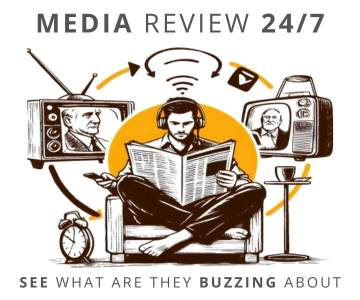10.02.2025 Skills and knowledge
AI Slop and Microtargeting. Why You Should NOT LIKE the Bread Horse
Bartłomiej Dwornik
"I grew this garlic chive all by myself on the windowsill. But I bet you won't congratulate me." Do you also see an influx of such posts in online communities? Be careful. This is called AI slop (or Boomer Trap), and it is NOT just a harmless game or entertainment. It is a well-thought-out mechanism in which the currency is you. First, your time and engagement. And soon, your money.
 illustration: DALL-E
illustration: DALL-ESocial media stopped being a place of spontaneous interactions and authentic content a long time ago. Today, it is a battlefield for user attention, with algorithms, data, and artificial intelligence as weapons. AI slop, a flood of low-quality, mass-generated content, has become the new reality of social platforms. The so-called Bread Horse, whose original and variations have been seen by almost everyone, is just the tip of the iceberg.
Microtargeting: The Art of Persuasion or Manipulation?
Microtargeting involves precisely tailoring content to specific recipients. Advertisers and politicians can use it to reach narrowly defined groups with messages perfectly suited to their views, preferences, and emotions. Artificial intelligence enables this on an unprecedented scale.
How does it work? Algorithms analyze our online behavior - likes, comments, clicks, search history -and then serve us content most likely to provoke a reaction. In theory, this sounds like a marketer`s dream. In practice? It depends on who uses this technology and for what purpose.
Every activity you engage in online - likes, clicks, comments, search history, time spent on a post -leaves a digital footprint. These data points are analyzed by algorithms that create your psychological and behavioral profile.
Based on this, advertisers, companies, and politicians can target you with hyper-personalized content that has the highest chance of capturing your interest. What kind of data is used?
- Demographics - age, gender, location.
- Interests - based on likes and followed pages.
- Online behavior - what content you react to, how long you view it.
- Purchase history - what you buy online and offline (yes, offline too - through loyalty programs).
- Opinions and emotions – which political or social posts you share.
Each of these elements helps create your consumer profile, which can be used to match content that most resonates with you.
Why Is Microtargeting Used?
Firstly: To Sell Products and Services. Companies want you to buy their products, but instead of bombarding everyone with the same ad, they prefer to show you something that truly interests you.
- If you`re into sports, you`ll see ads for sportswear.
- If you recently searched for a hotel, you`ll get travel offers.
- If you often like healthy eating posts, you`ll see meal plan ads.
- If you like the Bread Horse, you`ll get more Bread Horses. And other bread creatures.
This makes advertisements more effective, saving companies money by not displaying them to random people.
Another, less neutral area is politics and public opinion manipulation. This is the most controversial aspect of microtargeting. It can be used to influence public opinion and election outcomes.
- In the USA in 2016, Donald Trump`s campaign used microtargeting to send different messages to different groups. Undecided voters received emotional content meant to sway them towards Trump.
- Brexit - Proponents of the UK leaving the EU used microtargeting to amplify fears about immigration among conservative voters.
Political microtargeting allows narratives to be tailored to each audience separately, often manipulating their emotions.
Mass Content Generation and Emotional Automation
AI can generate hundreds of thousands of posts, memes, and articles in the time it takes a human to craft a decent headline. AI slop is the result of this mass production - tons of low-quality content with the sole purpose of capturing clicks.
Companies and marketing agencies can use this to reach every audience segment individually, offering perfectly tailored messages. Sounds great? Until you realize that most of these messages are worthless, repetitive, and created only to keep us engaged on social media.
Algorithms not only analyze our behavior but also learn to speak our language. AI can adapt communication style and tone to different demographic groups. Teenagers receive casual, meme-filled content, professionals get serious reports and analyses, while older users see emotional nostalgia-driven stories.
Sounds good? Maybe. But what if AI starts manipulating users’ emotions to elicit extreme reactions? It’s no coincidence that content evoking fear, anger, or excitement gets the most engagement.
Deepfake, Fake News, and Controlled Discussions
Microtargeting goes even further. AI can generate not only articles but also deepfakes - fake images and recordings that appear real. It can also create automated comments and reviews that seem authentic but are part of a planned campaign.
Readers believe they are engaging in an authentic discussion, unaware that some participants are bots driving a chosen narrative. This is not just advertising anymore but a strategy to shape public opinion.
Facebook, Instagram, Twitter, and TikTok have long optimized their algorithms to maximize engagement. AI-generated content is becoming increasingly difficult to distinguish from human-created content. Where does personalization end and manipulation begin?
Can anything be done? Yes. But only if users, platforms, and regulators start taking this issue seriously. For now, in the age of AI slop, algorithms decide what we read, believe, and how we perceive the world.
The question is: who will learn faster - us or them?
COMMERCIAL BREAK
New articles in section Skills and knowledge
How LLMs are reshaping SEO. Smart content strategies for the age of AI
BDw
For years, SEO was a fairly predictable game. Pick the right keywords, optimize your content, and watch your website climb the rankings. But today, a silent revolution is underway - and it`s being led by large language models (LLMs) like ChatGPT, Claude, Gemini, and DeepSeek.
Chronemics, or The Language of Time. What Your Watch Says About You
Bartłomiej Dwornik
You walk in on time, glance at your watch, wait five minutes, then leave. Someone else is thirty minutes late and acts like they had to wait for you. Time in communication is a tool, a weapon, and a status marker. Welcome to the world of chronemics. The study of how time affects human relationships.
Preschoolers Expose Hypocrites. Findings from SWPS University
ekr/ bar/
Even preschool children are able to recognize hypocrites, whom they rate worse than other people who break the rules, researchers from SWPS University in Poland demonstrate. Caregivers should therefore pay attention to whether their actions are consistent with their declarations, because children are careful observers of moral integrity.
See articles on a similar topic:
Common Mistakes in Creating Content for Websites
Bartłomiej Dwornik
What mistakes should you avoid at all costs to ensure that the often costly work of attracting traffic from Google doesn’t go to waste? Check out the insights from experts asked by Interaktywnie.com in the recently published report "Search Engine Marketing."
Visual Tricks. How to Influence People with Color, Shape and Composition
Bartłomiej Dwornik
The human brain supposedly processes images up to 60,000 times faster than words. Bright colors catch the eye more - but only under certain conditions. Few people can resist the "Apache Method," and a bearded man sells better. Here are some tricks for graphical-optical mind hacking.
Max Weber's Theory of Political Sociology
Krzysztof Dowgird
Max Weber, a German sociologist who lived from 1864 to 1920, was undoubtedly the greatest non-Marxist sociologist of political relations. He had a tremendous and enduring impact on many branches of social sciences, including the sociology of political relations.
Psychology of Politics: Extremism
Krzysztof Dowgird
The term "extremist," according to the dictionary definition, refers to "a person with extreme views, a radical, an advocate of extreme, ultimate measures." In relation to political extremism, this means, first, views of an extreme nature (including approval for the use of force to solve political problems).





























